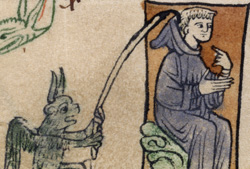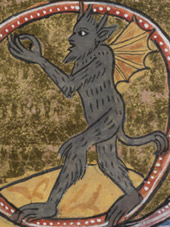 |
 |
 |
 |
 |
 |
 |
|
Crimes and misdemeanours (7/7) Life at Kirkstall and on its granges was not always peaceful and the community’s behaviour was at times far from pious - and even violent. In 1356 the abbot of Kirkstall was accused of leading a hitsquad of five monks and a lay-brother of the abbey, as well as four laymen, to besiege Thomas Sergeant’s house at Thorpe, near Knaresborough. The group allegedly damaged the building, stole Thomas’ goods and imprisoned him at Wetherby.(39) Ten years later the abbot was once again at the forefront of local thuggery when he and a lay-brother of Kirkstall, along with two widows, were said to have attacked the archbishop of York’s official, the vicar of Sandal, in an attempt to prevent Robert of Baghill’s widow, Margaret, from being summoned to appear before the archbishop. The vicar’s servant was killed in the brawl, but the lay-brother accused received royal pardon in 1371.(40) In 1377 Abbot John of Thornberg was brought before royal commissioners and charged with numerous offences that he and a certain merchant had allegedly committed. The crimes listed included entering houses and lands in York and elsewhere, attacking servants, destroying trees and hunting game.(41) Granges were frequently the centre of trouble and Kirkstall’s granges were no exception. At Micklethwaite, Adam the granger and others were accused of murder; at Barnoldswick Peter the granger cut off the ear of one of the serving boys who had stolen two loaves of bread.(42) The community was also reproached for transgressions of a less violent nature. In 1280 the Kirkstall monks were reported to the General Chapter for rebelling against their father abbot of Fountains, and accused of conspiring amongst themselves.(43) The precise cause of this is not known, but may have been related to the economic situation at this time or the deposition of Abbot Gilbert of Kirkstall, who had neglected to pay off their debts to Cardinal Jordan and the Jews.(44) Archbishop Greenfield admonished the community in 1314 for admitting parishioners of Leeds to sacraments in the chapel above their gatehouse, and receiving others for burial within the abbey grounds;(45) the latter presumably referred to burial within the church, although this is not stated explicitly in the document. |

